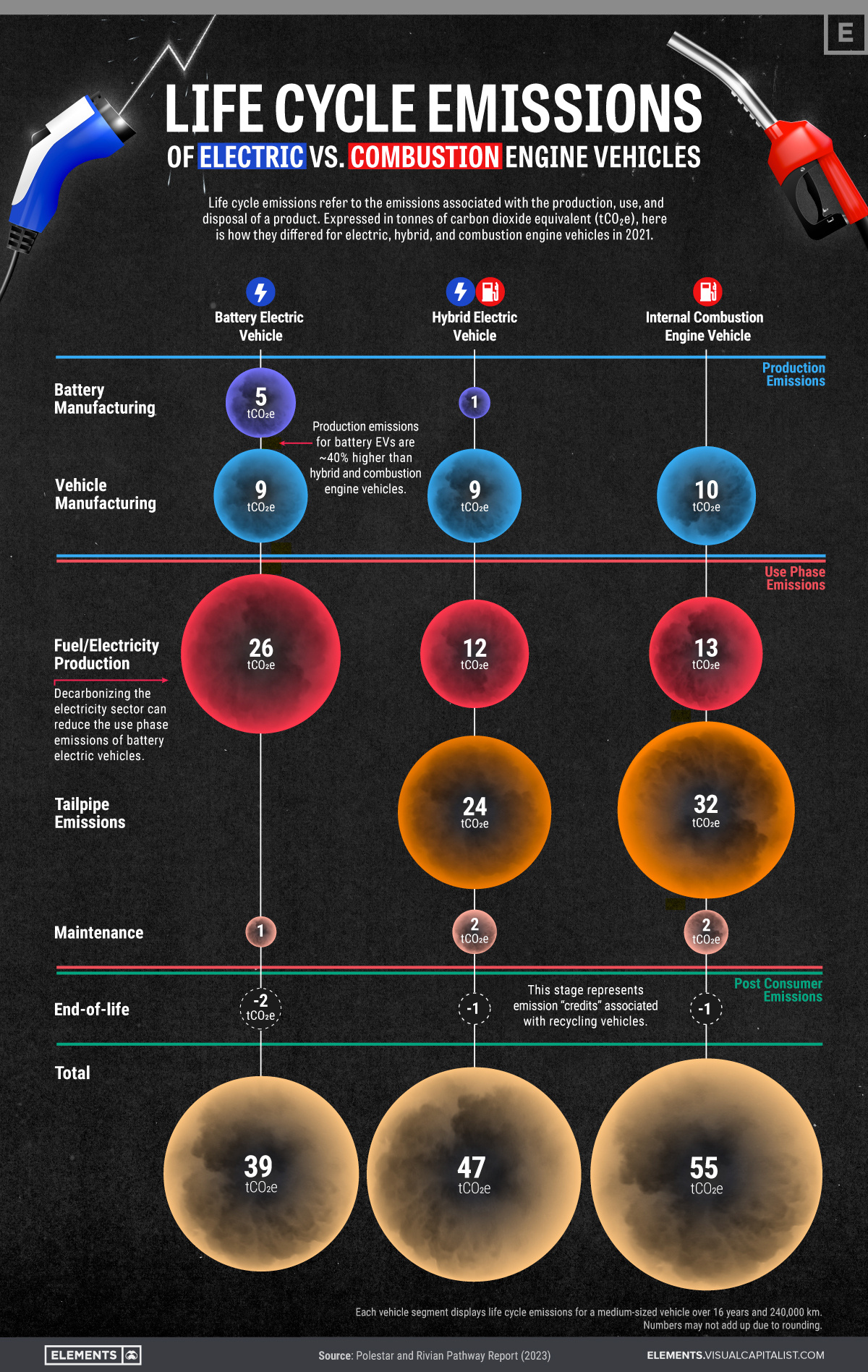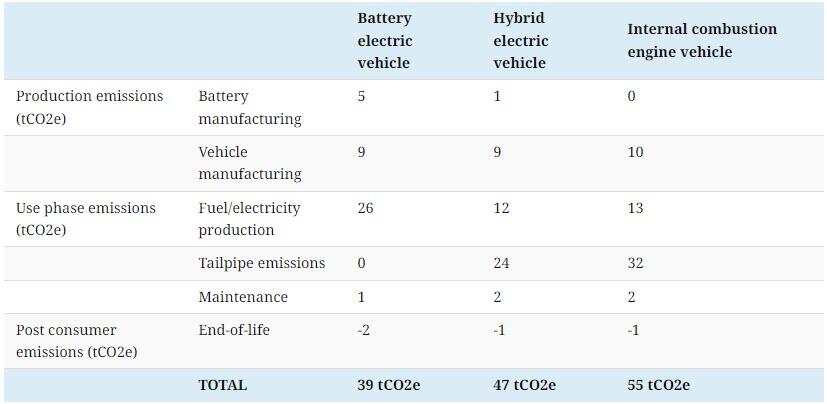
Posted on 07/03/2023 9:10:50 PM PDT by SeekAndFind

According to the International Energy Agency, the transportation sector is more reliant on fossil fuels than any other sector in the economy. In 2021, it accounted for 37% of all CO2 emissions from end‐use sectors.
To gain insights into how different vehicle types contribute to these emissions, the above graphic visualizes the life cycle emissions of battery electric, hybrid, and internal combustion engine (ICE) vehicles using Polestar and Rivian’s Pathway Report.
Life cycle emissions are the total amount of greenhouse gases emitted throughout a product’s existence, including its production, use, and disposal.
To compare these emissions effectively, a standardized unit called metric tons of CO2 equivalent (tCO2e) is used, which accounts for different types of greenhouse gases and their global warming potential.
Here is an overview of the 2021 life cycle emissions of medium-sized electric, hybrid and ICE vehicles in each stage of their life cycles, using tCO2e. These numbers consider a use phase of 16 years and a distance of 240,000 km.

While it may not be surprising that battery electric vehicles (BEVs) have the lowest life cycle emissions of the three vehicle segments, we can also take some other insights from the data that may not be as obvious at first.
As we move toward a carbon-neutral economy, battery electric vehicles can play an important role in reducing global CO2 emissions.
Despite their lack of tailpipe emissions, however, it’s good to note that many stages of a BEV’s life cycle are still quite emission-intensive, specifically when it comes to manufacturing and electricity production.
Advancing the sustainability of battery production and fostering the adoption of clean energy sources can, therefore, aid in lowering the emissions of BEVs even further, leading to increased environmental stewardship in the transportation sector.
Simple just build more /s
“Decarbonizing the electricity sector by implementing renewable and nuclear energy sources can significantly reduce these vehicles’ use phase emissions.”
Actually only small reductions in CO2 emissions are possible from the electricity generation system because wind power requires “spinning reserve” non-renewable backup power which wastes fuel and emits more CO2, and precludes the use of combined cycle gas turbines (the most efficient way to produce electricity) because CCGT can’t be used as backup power to wind because it takes too long to start the power plant.
Do the batteries even last 16 years?
I'm driving a 2001 F150 with 295,000 miles (474,756.48 km) and I'm quite sure it will make it to 400,000 miles. At that point, the entire truck can be scrapped and the sheet steel, cast iron and cast aluminum recycled into something new. I could also rebuild everything myself and run it to 500,000 miles.
It's all a mute point though since the infrastructure isn't there to charge all the vehicles if everyone goes EV.
“Does this include a factor in mining of the various ingredients if you will?”
Good catch. The artical says it is 40% for EV’s but it isn’t in the chart. Oh brother.
That chart isn’t even close to the cost of an EV.
It’s not really a fuel. It’s a storage medium for energy, like a battery. You need energy to make hydrogen to burn in an engine.
There is some minimum number of miles an EV or a hybrid has to go before it is worth having instead of an ICE vehical. For me, I simply don’t drive enough to make either an EV or a hybrid worth it. And after reading some of the great points made in this thread, I think that minimum number if miles is even higher than I previously thought.
Of course, that was without another factor I didn't consider: how much more my wife and I would be hot doggin' in the EV with its nearly instantaneous acceleration and its better handling of curves (for a crossover) because it has a lower center of gravity (where the battery is). LOL
As far as parking decks collapsing and some of the news saying they didn't account for weight of EV's --- maybe. It depends on how old the parking decks are. For example, probably no EV is close to the weight of my 1970's cars. LOL So parking decks made for those cars can easily handle the weight of modern EV's. The same for modern parking decks here in the south where a lot of people commute in pickups (myself included until my wife and I got the EV, and I still use the pickup either for pickup chores or the times my wife and I need separate cars for the day). So if I was still going to the office every day and I parked my EV in the deck instead of my mid-sized pickup, I'd be lowering the weight, not increasing it.
Back to my main point. Us conservatives look as dumb as liberals when we argue talking point "facts" (i.e. weight of EV's) as a counter-argument against the liberals. Always, always, always our main argument should be for freedom and free markets, not more government figuring out what's best for all of us. The Constitution doesn't allow liberals to talky-talk more government control over us, no matter how cult-like they make their warmageddon beliefs.
That’s a great point about the tree huggers not wanting to get within ten miles of a transmission line because the electric fields were going to cause cancer! I forgot about that.
BMW produced a small number of hydrgen vehicles in the early 2000’s and did a cross country tour with them during a simmer. they were higher end BMW’s as I recall because I saw them in Chicago. I was working for the legendary ad agency Leo Burnett at the time.
Hydrogen vehicles aren’t new and Toyota has produced hundreds of them for the Japanese market and is piloting them. In fact, Toyota Racing Division has a hydrogen powered vehicle they’ve been racing in Japan and elsewhere in Asia.
Toyota also has small hydrogen producing stations for them in Japan making refueling them pseudo-easy. Toyota’s been working on this for awhile, I follow it and read up on it when there are updates. Personally I think Hybrids are the future, Hybrid Hydrogen powered vehicles I think would be interesting.
Back to this study though: I don’t think it fully accounts for all the environmental damage and tailpipe emissions caused by mining for, shipping and refining the lithium and the manufacuring process for the lithium batteries.
Are EV’s really more environmenetally friendly? If all that’s being counted is fuel, maintenance and tailpipe emissions, then yeah, they are and I’d call that a rigged study.
All other factors in the full discovery, mining, refining, and manufacturing processes for the batteries for EV’s? Nope, that’s not environmentally friendly AT ALL.
I’ve always said a hybrid was the logical first step. A 40% reduction in fuel usage and easy to convert current car production.
+++++++++
And this is exactly how Toyota is approaching the whole EV market. Toyota is NOT stupid.
And PoleStar sounds like a strip joint.
Instead the powers to be mandated EVs by 2035. We will be lucky to get another copper mine by that time. I don’t know where all the materials are going to come from for all these EV.
My WAG is that it would take as much or more electricity to produce hydrogen as youd use in a battery car, but then you wouldn't have the "advantage" of limiting the peasants' travel which as near as I can tell is the real motivating force behind the governments effort to ram EVs down our throats and up our other orifices.
While I disagree with you on the weight overall - your single example does not generalize the issue, I agree with the rest of what you said. I feel the EV concept is fundamentally flawed in that fossil fuels are burned to make mechanical work which is then used to generate electricity which then goes through a series of transformations to produce mechanical work that could have been done by burning the fossil fuel directly in the vehicle. I just can’t see how this process is more inefficient than the direct conversion at the vehicle.
It’s not a “fuel”, just like electricity is not a “fuel”.
One uses hydrogen or electricity to transfer energy from a coal plant, a natural gas turbine, a nuke reactor, a solar cell, or a wind turbine to its end use, whether that is a motor, toaster, TV, etc.
Depends on what emissions you’re talking about, and I wasn’t focusing on emissions per se.
And fuel economy is but one concern; there have been many automobiles, particularly from the 80s, that actually got similar or even superior MPG numbers, although the tradeoff was performance-related, particularly with acceleration etc.
Since the article uses "tons of carbon dioxide equivalent (tCO2e)," I'm going to say that one.
There is an 8 tCO2e difference between EV and hybrid, but an EV needs two charges (assuming a 200 mile range) for one fill-up of a hybrid (assuming a 400 mile range).
According to the chart, the energy production phase is the highest emissions producer, 27 (EV) vs 38 (hybrid). With two charging cycles per one fill-up, that means the EV emits 54 vs 38 for the hybrid per charges/fill-ups per 400 miles driven.
That wipes out the total 8 tCO2e lead for the EV and gives the hybrid a net total 8 tCO2e lead over the EV per 400 miles driven.
-PJ
That’s all down to emissions control, not fuel consumed. The article is pushing battery cars, remember.
Disclaimer: Opinions posted on Free Republic are those of the individual posters and do not necessarily represent the opinion of Free Republic or its management. All materials posted herein are protected by copyright law and the exemption for fair use of copyrighted works.